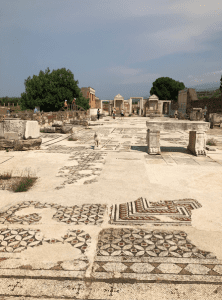Reading Revelation well means reading it in light of the End of all Ends, which means in some ways learning to read it backwards. It’s too easy to equate a book like this with our penchant for inductive arguments, but Revelation won’t cooperate.
The End of Revelation is the point from the very beginning. To wait, unless you are engulfed in reading it as if for the first time, is to risk not knowing where it’s headed. Once you know where it is headed you know where you are on the map.
There are a number of good books on Revelation, and we are focusing on both Craig Koester, Revelation and the End of All Things, and in a lesser way on Ian Paul, Revelation. I once blogged here about Michael Gorman’s very fine book, Reading Revelation Responsibly, and I give it a strong recommendation along with Koester’s book.
So, let’s turn to Koester’s sketch of the end. (And do buy this book. It’s a brief commentary-hermeneutic.)
The sixth and final cycle of visions begins after the announcement that “the marriage feast of the Lamb has come” (19:7). One would think that if “the bride has made herself ready” in her gown of pure white linen, readers should soon see her process down the aisle to the sound of heavenly music. But in Revelations predictably unpredictable vision of things, events take a different turn. The bride may be ready, but readers will not see her until a thousand years have passed; and while they wait, they see the Lamb—the groom at this wedding (19:7, 9)—thundering onto the page to slay the adversaries of God. Those hoping for a glimpse of “the marriage supper of the Lamb,” with its tables laden with fine food (19:9), are instead given a revolting specter of “the great supper of God” (19:17), in which the birds of heaven are invited to feast on the slaughtered who lie on the battlefield.
Is this the End of all things? Does this carnage mark the culmination of God’s purposes?
In reading many one would think so. But that carnage and destruction are not the End. The End is gloriously different. The End tells us how to read the Book, and it directs us away from carnage toward the Lamb on the Throne. Koester continues…
John indicates that “No, there is more.” And he tells of Satan being bound with a chain and hurled into the great abyss, whereas those who have resisted the beast and those who have been killed for their faith are raised to life so that they serve as priests and reign with Christ (20:1-6). Is this millennial kingdom of the redeemed the End of all things? Again, the answer is “no,” for Satan is released to mount yet another attack on the saints, only to have his plot foiled by heavenly fire. All the dead are raised to stand before the throne of God, and the last judgment takes place. Then the bride of the Lamb, whose coming was announced before, descends in splendor as the new heaven and earth appear (21:1-2). The bride is the New Jerusalem, and it is here that Revelations dizzying spiral of visions comes to its end. John takes readers on a tour of the city, showing them its pearly gates and streets of gold, its tree of life and river of living water. Yet even here John points his readers to something more.
The mystery of the End is revealed through the voice of God, who declares that “I am the Alpha and the Omega, the beginning and the end” (21:6), and through the voice of Christ, who says, “I am the Alpha and the Omega, the first and the last, the beginning and the end” (22:13). To use the words of Revelation itself, the End of all things is God and the Lamb. This startling disclosure brings us back to where we began. Readers are like travelers, who climb mountains and cross valleys, who swelter in the day and grope through the darkness at night, contending with plagues, tyrants, and wild beasts, only to find themselves back on their front doorstep, looking at the view with new eyes. Already in chapter 1, God and Christ declared that they are the beginning and the end (1:8,17), and the visions that follow show readers the implications of what it means to know that “the end is not an event, but a person” (Caird, A Commentary, 266).
Authentic prophecy is known by what it does: true prophecy moves people to worship God and false prophecy draws people away from God. … When Revelation moves people to faith in God and the Lamb, it brings them to the End for which the book was written.












